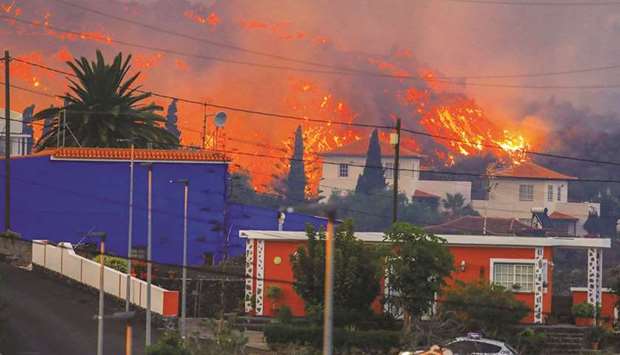A surge of lava destroyed around 100 homes on Spain’s Canary Islands a day after a volcano erupted, forcing 5,500 people to leave the area, local authorities said yesterday.
The Cumbre Vieja erupted on Sunday afternoon, sending vast plumes of thick black smoke into the sky and belching molten lava that oozed down the mountainside on the island of La Palma.
No fatalities or injuries have been reported but drone footage captured two tongues of black lava cutting a devastating swathe through the landscape as they advanced down the volcano’s western flank towards the sea.
A Reuters witness saw the flow of molten rock slowly tear its way through a house in the village of Los Campitos, igniting the interior and sending flames through the windows onto the roof.
Authorities have not given an updated tally of how many properties have been destroyed since the head of La Palma’s local government gave an estimate of 100 early on yesterday.
“We haven’t had any loss of human life, which is the best news,” said Angel Victor Torres, regional head of the Atlantic archipelago, which lies off the coast of Morocco.
According to Involcan, the Canary Islands’ volcanology institute, the lava flows were moving about 700m per hour, and had a temperature of nearly 1,000° Celsius (1,830° Fahrenheit).
The eruption on this island of some 85,000 people, the first in 50 years, has caused significant damage with “around 100 homes destroyed”, said Lorena Hernandez Labrador, a councillor in Los Llanos de Ariadne which lies northwest of the volcano.
Dramatic images on social media showed huge rivers of slow-moving lava creeping down the mountainside, pockets of flame erupting as it consumed trees and surged over trees and buildings caught in its path.
Describing the scene as “desolate”, La Palma’s top official Mariano Hernandez Zapata said the lava was “on average about 6m (20’) high”.
“This tongue of lava is engulfing everything in its path. It’s tragic to see how many homes have just gone up in smoke,” he told Spain’s public television.
La Cumbre Vieja straddles a ridge in the south of La Palma, which is one of the most western of the seven islands in the archipelago.
Experts had been keeping a close watch on the volcano after observing a recent upsurge in seismic activity and magma displacements.
An “earthquake swarm” – a sequence of seismic events occurring over a short period – began on September 11.
Since then, there have been tens of thousands of tremors, the strongest with a magnitude of nearly four, Involcan said.
The last eruption on La Palma was in 1971 when another part of the same volcanic range – a vent known as Tenegia – erupted on the southern side of the island.
Volcanology expert Stavros Meletlidis from Spain’s National Geographic Institute said it was too early to say.
“There are volcanoes in the Canary Islands that have erupted for days and others that have continued for several years,” he told Spain’s public television. “We are following the volcano’s activity very closely.”
Prime Minister Pedro Sanchez, who flew into La Palma on Sunday after cancelling a trip to New York for the UN General Assembly, said the priority was “to ensure people were safe”.
“The volcano is still active,” he warned, predicting there would be “some very long days ahead”, he told a news conference.
Tourism Minister Reyes Maroto said the eruption was “a wonderful show” which would attract more tourists – comments that were criticised by the opposition at a time when many residents have lost their homes.
Some of the tourists at the airport disagreed with the minister.
“We want to leave as fast as possible,” said Wienard, a 55-year-old social worker from Salzburg.
But at least one visitor was happy.
“I felt like a little child inside, very excited,” said Kabirly, 26, a market researcher from Belgium. “It was also my birthday yesterday so it was sort of a candle on the island cake!”
About 360 tourists were evacuated from a resort in La Palma following the eruption and taken to the nearby island of Tenerife by boat early yesterday, a spokesperson for ferry operator Fred Olsen said.
A total of more than 500 tourists had to leave their hotels.

Lava flows behind houses following the eruption of a volcano in the Cumbre Vieja national park at Los Llanos de Aridane, on the Canary Island of La Palma.

